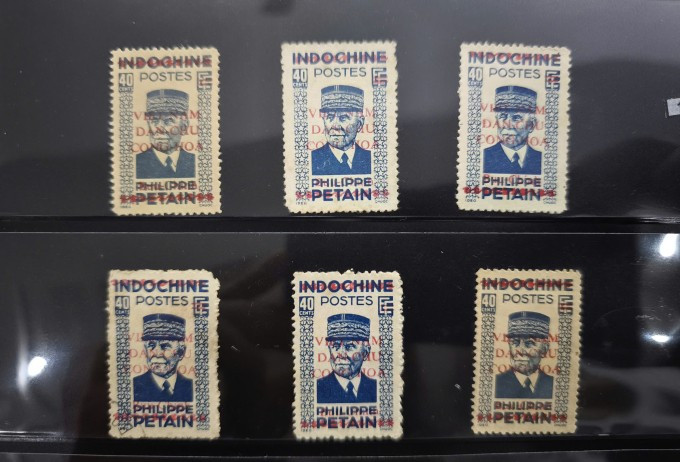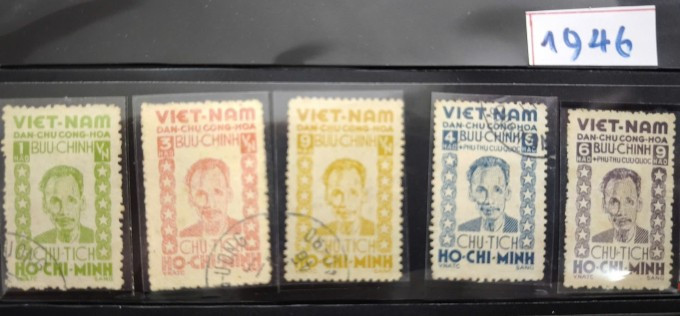Immediately after the August Revolution in 1945, when the Democratic Republic of Vietnam was born, the Government issued Vietnamese postage stamps to replace the old stamps of the colonial government, which clearly printed the word "INDOCHINE" and were used jointly for the three Indochinese countries of Vietnam, Laos, and Cambodia.
However, in the context of a young country, all resources were focused on protecting independence, the issuance of new stamps was postponed. Instead, a timely and creative solution was applied: overprinting old Indochina stamps.
Researcher Pham Tue (81 years old, in Hai Phong City), who owns 12,000 postage stamps from Vietnam and many other countries, said that the Democratic Republic of Vietnam used 57 old Indochina stamps, erased the word "INDOCHINE" and printed over them the words "VIET NAM DAN CHU CONG HOA" or "VIET NAM DOC LAP TU DO HANH PHUC" in red ink for use in the first year after the August Revolution. These stamps were sent everywhere, even abroad, as an affirmation of the country's sovereignty and independence.

On July 28, 1946, on the occasion of the first anniversary of the successful August Revolution and the founding of the Democratic Republic of Vietnam, the President signed Decree No. 172/SL allowing the Vietnam Post Office to print and issue the first set of stamps of independent Vietnam.
The stamp set with the image of President Ho Chi Minh was drawn by artist Nguyen Sang, with 5 colors: green, red, yellow, blue, purple, printed at the Vietnam Printing Office. Of which, the three designs of green, red, and yellow have face values of 1, 3, and 9 hao respectively. The designs of blue 4 hao and purple 6 hao have an additional national salvation surcharge of 6 and 9 hao respectively.
"This is the first time a purely Vietnamese stamp has the word Vietnam on it along with the image of the leader who founded the Democratic Republic of Vietnam. Therefore, this stamp has great significance in many aspects of politics, culture, art, economy, society...", Mr. Tue assessed.

The second set of stamps was issued in May 1949 to commemorate the 59th birthday of President Ho Chi Minh, also drawn by artist Nguyen Sang and printed at the Viet Bac Central Printing House in Phu Tho.
The third set of stamps issued in 1951 to commemorate the 61st anniversary of President Ho Chi Minh's birthday, printed with the image of President Ho Chi Minh along with a map of Vietnam and a 5-pointed star in three colors: green, brown and red, corresponding to the denominations of 100, 100 and 200 dong. The stamps were drawn by artist Bui Trang Chuoc and printed at the Viet Bac Central Printing House. What is special is that this set of stamps is made of Do paper, which is thin but very tough and durable, and after 74 years the quality is still good. This third set of stamps may be the only one in the world made of Do paper.
In stamp set No. 11, issued in October 1954 to commemorate the Dien Bien Phu victory, in addition to the three denominations of 10, 50, 150 dong, there is also an official stamp with a face value of 0.6 kg of rice. "It is also the only stamp in the world with such a face value," said Mr. Tue.
The researcher, who owns almost all stamps of the Democratic Republic of Vietnam from 1945 to 1975 and stamps of the Socialist Republic of Vietnam from 1975 to the present, said that each stamp is not only for paying postage but also contains a lot of useful information. On the postage stamps, there is always the name of the issuing country accompanied by illustrations of historical, geographical, political events, people, organizations, society, scenic spots, nature..., symbolizing the traditions and values of each country.
Recently, the Ministry of Science and Technology in collaboration with the Central Propaganda and Mass Mobilization Commission and the Ministry of Culture, Sports and Tourism issued a set of postage stamps commemorating the 80th anniversary of the National Day of the Socialist Republic of Vietnam, including one stamp and one block. The stamp depicts the image of President Ho Chi Minh, depicted in a modern graphic art style, both solemn and familiar.
The block template shows the National Emblem of the Socialist Republic of Vietnam and the map of the Fatherland. The block background uses the image of a bronze drum, a symbol that reminds us of the historical roots and depth of national culture.
Source: https://baohatinh.vn/nhung-mau-tem-phat-hanh-sau-ngay-doc-lap-post294785.html



![[Photo] National Assembly Chairman Tran Thanh Man attends the VinFuture 2025 Award Ceremony](/_next/image?url=https%3A%2F%2Fvphoto.vietnam.vn%2Fthumb%2F1200x675%2Fvietnam%2Fresource%2FIMAGE%2F2025%2F12%2F05%2F1764951162416_2628509768338816493-6995-jpg.webp&w=3840&q=75)
![[Photo] 60th Anniversary of the Founding of the Vietnam Association of Photographic Artists](/_next/image?url=https%3A%2F%2Fvphoto.vietnam.vn%2Fthumb%2F1200x675%2Fvietnam%2Fresource%2FIMAGE%2F2025%2F12%2F05%2F1764935864512_a1-bnd-0841-9740-jpg.webp&w=3840&q=75)











































































































Comment (0)